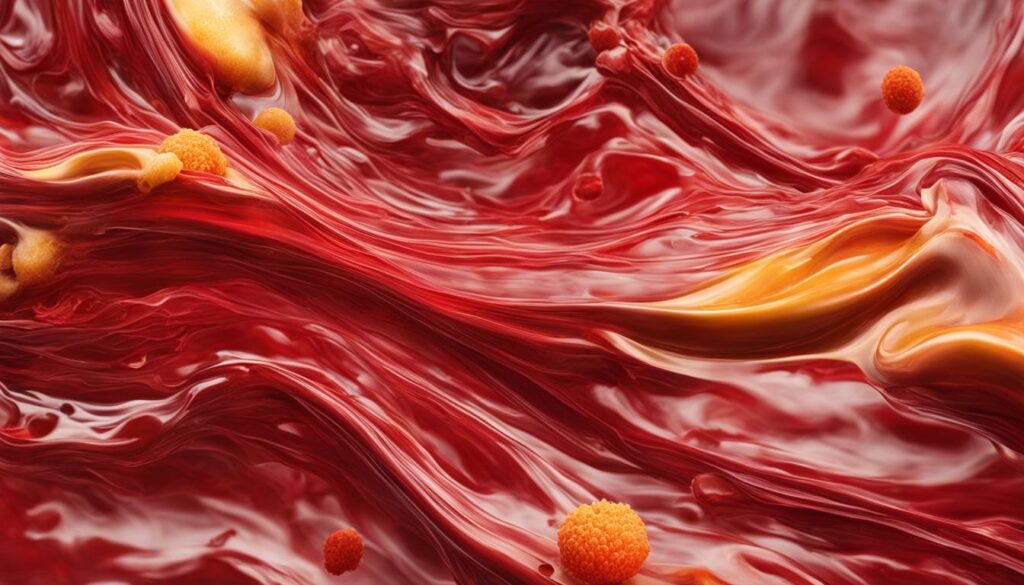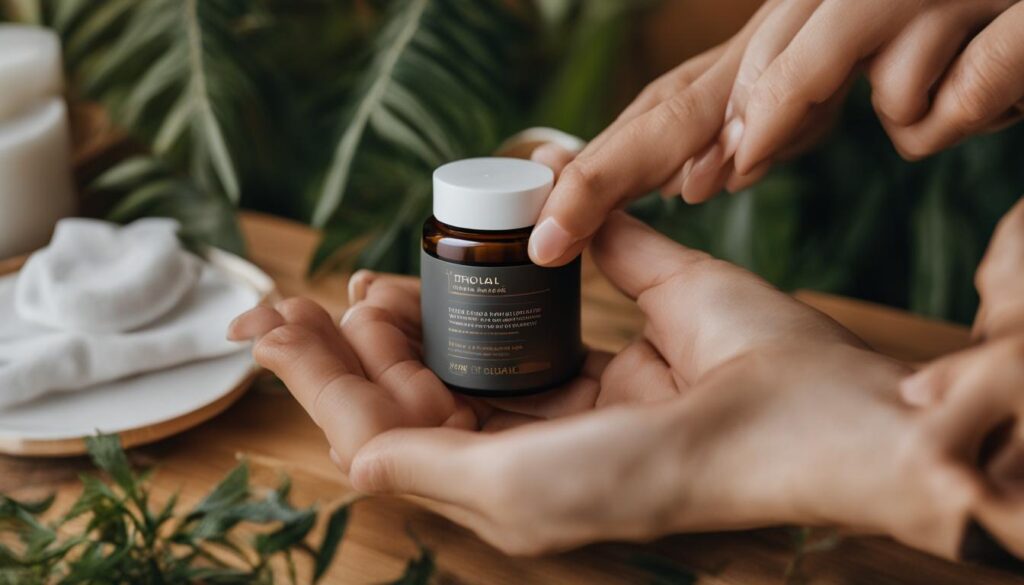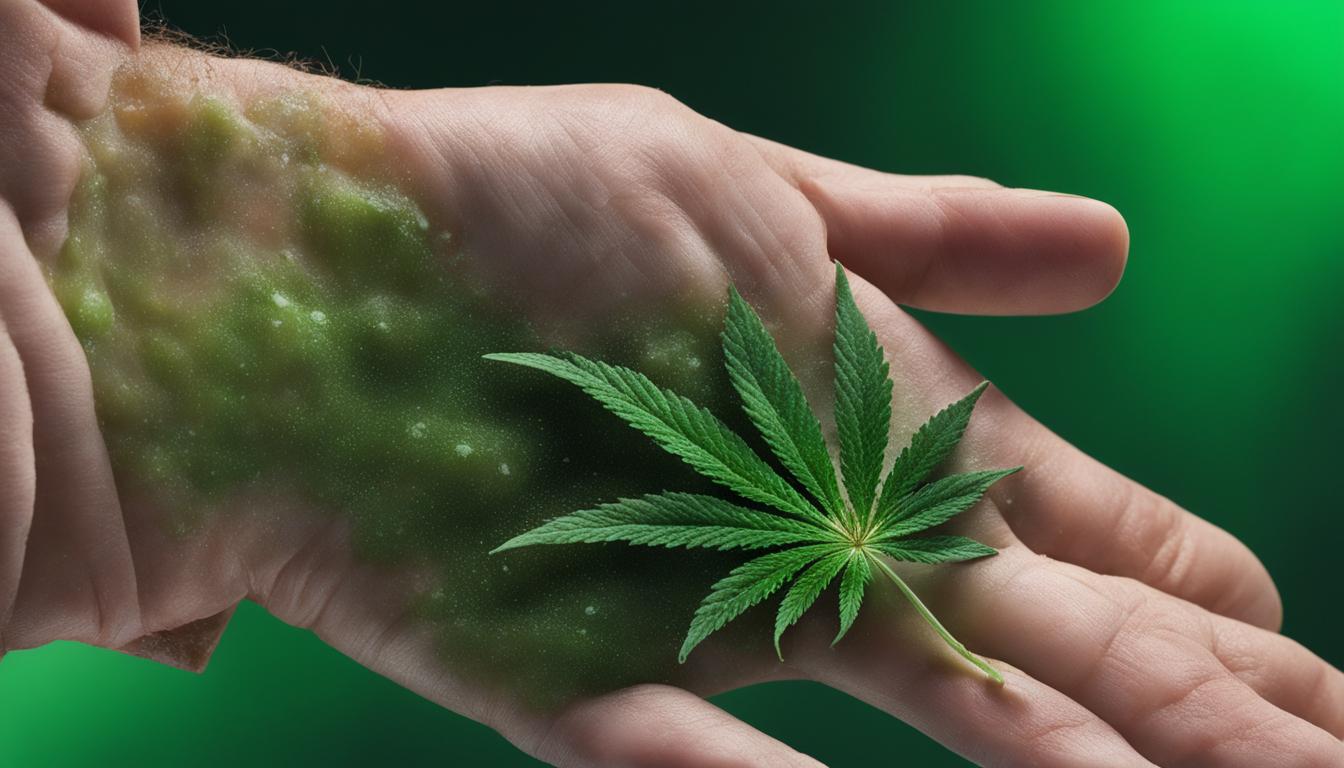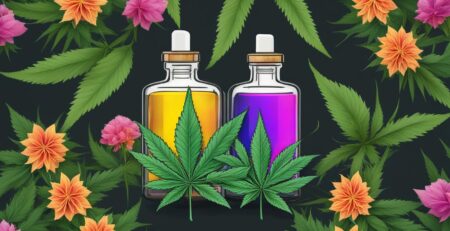Topical THC Side Effects: Know the Risks
The burgeoning popularity of topical THC products such as creams and lotions has coincided with an increasing push for consumer awareness about potential cannabis topical side effects. While such topicals offer an alternative method of experiencing the benefits of marijuana without psychoactivity, they are not without their risks. Notably, the absence of FDA approval for these products reveals a gap in official safety standards, which often translates into consumer misconceptions about marijuana cream side effects and product reliability. Understanding the topical THC side effects is crucial for informed decision-making, especially when these products may interact adversely with other medications, lead to liver toxicity, or cause reproductive and developmental issues. Even more worryingly, the possibility for unintended intoxication remains an ever-present threat, particularly amongst children who may be inadvertently exposed to such compounds.
Key Takeaways
- Topical THC products lack FDA approval and may cause serious side effects.
- Users often misunderstand the risks associated with cannabis topical side effects.
- Marijuana cream side effects can include adverse drug interactions and liver toxicity.
- Accurate labeling and consumer awareness are essential to prevent unintended intoxication.
- More clinical research is necessary to establish the safety and efficacy of these products.
- Children's exposure to THC through topicals is a particular area of concern.
Understanding Topical THC and Its Growing Popularity
With the rapid ascent of cannabis products in the health and wellness arena, topical THC formulations like creams, salves, and lotions have garnered significant attention for their purported health benefits. These products are crafted for their localized effects and are primarily used externally on areas such as the skin, hair, and nails. As legislation evolves and consumer curiosity heightens, an exploration into the effects and applications of topical THC is warranted.
The Definition and Distinction of Topical THC
Topical THC products are characterized by their ability to provide targeted relief without the psychoactive experiences associated with traditional cannabis consumption. By penetrating the skin's surface, these topicals are thought to interact with local receptors, potentially offering an analgesic or anti-inflammatory response—key attributes that elevate their appeal in tackling discomforts like arthritis and skin irritations. Yet, despite such potential benefits, concerns about thc cream side effects remind users of the need for caution.
Trends in Topical THC Usage
The surge in the use of topical THC is in part attributed to recent changes in cannabis regulation and a growing societal acceptance of its therapeutic use. However, while manufacturers claim a spectrum of benefits, clinical evidence supporting the effectiveness of these products is limited, leading to an uncertain landscape where anecdotes often shape perceptions of efficacy and safety, including potential topical thc side effects.
The Appeal of Non-Psychoactive Application
Drawing considerable interest, non-psychoactive applications of THC in the form of topicals have captivated a diverse demographic. These consumers are embracing the possibility of attaining symptom relief without the high, suggestive of an emerging trend in personal health management. Nevertheless, the potential side effects of topical THC and the lack of regulation signal a pressing need for more substantial scientific studies, particularly when the purity and content of these products remain largely unverified, raising concerns over CBD cream side effects as well.
As we continue to unravel the nuances of topical THC's role in modern wellness, it's evident that these products have tapped into a health-conscious zeitgeist. But as popularity climbs, users and healthcare providers alike must navigate a marketplace as complex as it is promising, weighing anecdotal success against empirical scrutiny and user experience against potential risk.
Cannabis Sativa and Its Cannabinoid Compounds
The Cannabis Sativa plant, an abundant source of over 500 chemical substances, harbors a rich profile of more than 100 cannabinoids, with CBD (Cannabidiol) and THC (Delta-9-tetrahydrocannabinol) being the most significant. The diversity and complexity of compounds found in Cannabis Sativa account for its multifaceted applications and the associated topical cannabis side effects that users must be aware of.
Exploring CBD and THC
CBD, revered for its non-psychoactive properties, is often sought after for its therapeutic potential without the intoxicating effects typically linked to its counterpart, THC. On the contrary, THC is the main psychoactive component that delivers the “high” sensation but raises concerns due to the possible THC lotion side effects, such as skin irritation or more systemic issues when used in large quantities or on compromised skin.
Receptors in the Skin: How Topicals Work
The human skin is more than just a barrier; it is a biologically active field studded with cannabinoid receptors that make the side effects of THC salve a topic of rigorous study and discussion. When topicals infused with cannabinoids are applied, they may interact with these receptors, mediating localized effects such as pain relief or reduction in inflammation. Despite this, the full scope of effectiveness and safety remains under-researched, creating an atmosphere of caution around the use of topical cannabis side effects.
Considering the thrust towards popularizing these products, the need for comprehensive clinical trials and research into the subject is urgent. Until then, consumers are advised to be vigilant about the potential implications of using topicals derived from Cannabis Sativa.
The Legal Landscape of Topical THC
Since the passage of the Agriculture Improvement Act of 2018, also known as the Farm Bill, the legal framework surrounding hemp-derived products, including those claiming to alleviate marijuana cream side effects, has seen substantial change. By legally differentiating hemp from marijuana based on delta-9 THC content, with hemp containing no more than 0.3%, this legislation has markedly boosted the accessibility of cannabinoid products to a majority of US states. The act has catalyzed the introduction and distribution of a varied array of topical THC offerings in the marketplace, each promising a range of health benefits without the high.
Nonetheless, the landscape for THC cream side effects and related hemp-derived products is complex, entwined in both federal oversight and diverse state regulations. Despite their burgeoning popularity and availability, the legalities regarding the sale and usage of these products can significantly vary, with some jurisdictions implementing more rigorous restrictions than others. As a result, consumers must navigate a patchwork of laws that could influence the legality, perceived safety, and capability to purchase or use these items depending on one's location.
Amidst this evolving legal territory, the concern for marijuana cream side effects persists, magnified by the fact that the FDA has not approved most of these products. Consequently, issues arise from the lack of standardized content, which results in unpredictable product reliability and safety. Awareness of both the potential THC cream side effects and the differing regulatory frameworks is indispensable for users of topical THC products who aim to make informed and legal health decisions.
To offer a clearer perspective, consider the following contrasting scenarios:
| State / Regulation | Legal Status of Hemp-derived Topicals | Consumer Accessibility | Implications for Users |
|---|---|---|---|
| States aligning with Farm Bill | Legal for sale | Highly accessible in stores and online | Fewer reservations about use, but potential quality concerns |
| States with stringent regulations | Restricted or regulated sale | Limited access and availability | Increased importance of due diligence and legal awareness |
This diverse legal ecosystem influences both the market's array of topicals and the user's experience, with varying degrees of availability and oversight. Even as the legal status of these products is determined by the intricate balance of federal and state laws, one constant remains: the necessity to navigate the legalities prudently while staying abreast of any changes in legislation that may affect access to, and the safety of, THC-infused topicals.
Topical THC Side Effects
The conversation around therapeutic cannabis often focuses on the benefits, with less attention given to the topical THC side effects that can arise. Unlike ingesting or inhaling cannabis, topical applications are designed to exert local effects. Yet, even these target-specific remedies come with their slate of side effects, which can be particularly problematic when using THC-infused topicals not subjected to rigorous regulation and quality checks.
Common Unwanted Reactions
Amidst the various applications of topical THC products lies a potential for undesired reactions. Common issues encountered by users range from relatively mild skin irritations to more pronounced dermatological concerns.
- Rash
- Contact Dermatitis
- Urticaria (Hives)
- Itching
These reactions highlight the need for a cautious approach, particularly for individuals with sensitive skin or a history of allergic reactions to skin care products.
Adverse Skin Reactions to THC Infused Topicals
Delving deeper into adverse skin reactions, one finds that cannabis topical side effects can extend beyond mere discomfort. The lack of regulation in the cannabis market can mean THC-infused topicals house more than just the intended cannabinoids.
| Side Effect | Potential Cause | Risk Factor |
|---|---|---|
| Contact Dermatitis | Contaminants like pesticides | High, especially with non-regulated products |
| Systemic Absorption | Use on compromised skin or transdermal patches | Moderate to high, depending on product formulation and skin integrity |
| Infection Risk | Interference with normal skin barrier function | Moderate, particularly if used before dermatological procedures |
| Altered Healing | Unknown interactants or impurities altering skin's healing process | Variable, research is limited |
The potential for topical THC side effects emphasizes a larger conversation about the safety and efficacy of these products, especially when considering use in large doses or on children's delicate skin.
As consumers navigate the burgeoning landscape of cannabis-based products, understanding both the therapeutic possibilities and the risks associated with topical THC is vital. All signs point to the need for stricter regulation, accurate labeling, increased consumer education, and more rigorous scientific studies to help shape informed decisions and policies concerning these potent, yet enigmatic products.
Risks of Unregulated Topical THC Products
In the rapidly expanding world of cannabis products, the safety of topical THC formulations is a growing concern. Without proper regulation, these products pose significant risks for consumers. A critical review of these risks reveals several areas where users may face unexpected and potentially harmful side effects.
Labeling Inaccuracies and Misrepresentations
Consumers rely on product labels to make informed choices, especially when it comes to the content of substances they apply to their skin. However, in the case of many THC-infused topicals, accuracy in labeling is not guaranteed. These inaccuracies lead to misinformation and can mislead consumers looking to avoid THC lotion side effects. Whether due to oversight or deliberately misleading marketing, the ramifications of incorrect labeling are broad and concerning.
Potential for Contamination
Without strict oversight, there's no assurance of the purity of ingredients used in topical THC products. This results in a greater risk of contamination with hazardous substances, which can range from pesticides to unintended psychoactive compounds. Such contamination not only increases the risk of topicals with THC side effects but also can pose serious health risks, particularly for individuals with compromised immune systems or sensitive skin.
Unintended THC Exposure
One of the most alarming risks associated with unregulated topical THC products is the potential for unintended exposure to THC. This is problematic not only for adults who may inadvertently consume higher levels of THC than intended but also for children, who are at risk of accidental exposure. Such incidents highlight the crucial need for clearer regulation and education surrounding the use of cannabis-infused topicals and their potential cannabis topical side effects.
As the market for these products continues to grow, it becomes increasingly important to address these issues to ensure the safety of consumers and the integrity of the topical THC product industry.
The Potential for Intoxication
As topical THC products gain attraction for their presumed health benefits, apprehensions about marijuana cream side effects also rise, particularly regarding psychoactivity and systemic absorption. These concerns address the degree to which THC might penetrate the skin to produce psychoactive effects akin to those experienced when the cannabinoid is ingested or inhaled.
Understanding Psychoactivity and Topical THC
THC's notoriety as a psychoactive compound has seeded caution among users of marijuana-infused topicals. Although the primary route of THC's mind-altering effects is through ingestion or inhalation, the possibility of psychoactive responses from topical application has not been completely dismissed. This awareness has led to a critical examination of product types, especially in the context of THC cream side effects.
Systemic Absorption Concerns
The skin serves as a significant barrier to absorption; however, certain forms of topicals, such as transdermal patches, are designed for penetration beyond the dermal layer. The potential for THC to enter the bloodstream and elicit psychoactivity becomes a tangible concern when used on compromised skin. Consumers considering the use of THC-infused topicals must stay informed about possible topical cannabis side effects and the scenarios under which systemic absorption might occur, thereby mitigating the risk of unintentional intoxication.

Given these considerations, a deeper understanding and further research into the topical THC side effects will serve consumers and the medical community as they navigate these relatively uncharted waters. The cautious use of topical THC, accompanied by judicious consideration of existing medical studies and user reports, is crucial for those seeking therapeutic benefits without unintended consequences.
Consumer Usage Reports vs. Scientific Evidence
The burgeoning discourse within the realm of topical THC usage is marked by a stark contrast between enthusiastic consumer usage reports and the empirical clarity of scientific evidence. On one end of the spectrum, personal testimonials replete with success stories highlight significant improvements credited to the use of various CBD and THC lotions for common afflictions ranging from arthritis to eczema. These users are quick to ascribe relief of symptoms to their chosen remedies, often underlining a perceived lack of CBD cream side effects.
However, a rigorous scientific lens paints a more reserved picture. Despite the flood of anecdotal affirmations, the lack of substantiated data through well-designed randomized controlled trials (RCTs) is glaring. Notably, existing studies have been criticized for their methodological shortcomings. Without proper blinding, control groups, objective outcome measures, and comprehensive reporting of THC lotion side effects, these pieces of research fall short of the robust evidence needed to firmly legitimize the efficacy of topical THC products.
The placebo effect further complicates the assessment, muddying the waters between actual therapeutic benefits and mind-over-matter outcomes. The intricate biophysical process of skin absorption of cannabinoids, and by extension the potential side effects of topical THC, necessitates an in-depth examination under the clinical trial paradigm to unravel the truth behind these popular narratives.
| Aspect | Consumer Reports | Scientific Evidence |
|---|---|---|
| Evidence Type | Anecdotal | Empirical |
| Conditions Reported | Arthritis, pain, eczema, psoriasis | Limited study |
| Side Effects Discussed | Minimal to none | Insufficiently reported |
| Reliability | Subjective | Objective (when available) |
| Placebo Effect Consideration | Rarely acknowledged | Often considered in trial design |
Given these discrepancies, professionals and consumers alike grapple with a dichotomy—should one lean towards enthusiastic user experiences or hold out for the rigor of scientific validation? Until conclusive research fills the current knowledge gap, the community is left to balance optimism with skepticism regarding topical THC and CBD cream side effects.
Interactions with Medications and Drug Testing
When considering the use of THC-infused topicals, it's essential to understand their potential to interact with other medications, as well as their possible implications on drug tests. Despite their localized application, these products may be absorbed systemically, leading to unintended consequences that users need to be aware of.
Topical THC and the Risk of Drug Interactions
Topicals containing THC can lead to side effects of THC salve, including drug interactions that may affect an individual's overall wellbeing. While many patients turn to topicals to avoid the psychoactive effects associated with other forms of THC consumption, they may unknowingly expose themselves to a risk of interaction with other medications. This points to the necessity for consumers to discuss their use of these products with healthcare professionals, especially when taking other drugs for chronic conditions.
Workplace and Medical Drug Testing Considerations
Concerns regarding topical thc side effects are not limited to direct health impacts but also extend to practical considerations in the workplace and healthcare settings. Topicals with THC could potentially influence results of medical or workplace drug tests, though the likelihood of testing positive is generally lower than with inhaled or ingested forms. Nevertheless, accuracies in labeling are paramount since mislabeled content could result in unexpected topicals with THC side effects, such as failing a drug test. Consuming with caution is therefore critical for those undergoing regular drug screenings.
Guidelines for Safe Topical THC Use
In navigating the emerging territory of THC-infused topicals, a keen understanding of dermatological implications is crucial. While the potential benefits draw interest, the absence of comprehensive safety data requires a cautious approach to usage, particularly among those with skin sensitivities. Highlighting both the therapeutic possibilities and the associated risks, the following guidelines present best practices for engaging with topical THC products responsibly.

Dermatological Best Practices with THC Creams
Amid the myriad choices of cannabinoids for topical application, the allure of THC creams persists. Yet, due to limited research data, vigilance is advised to mitigate the risk of compounds exacerbating skin conditions. Consider the following recommendations:
- Initiating small-scale patch tests to check for adverse reactions.
- Selecting products with transparent ingredient lists and third-party test results.
- Avoiding application on open wounds or inflamed skin to prevent potential topical thc side effects.
- Monitoring skin responses closely to detect early signs of CBD cream side effects or other irritations.
- Consulting with dermatologists, particularly for users with pre-existing skin conditions or concerns about the side effects of thc salve.
Usage Considerations for Compromised Skin
Individuals with damaged or compromised skin integrity should be acutely aware of the nuanced impact of topical THC. Healing skin is more permeable, potentially leading to increased absorption, which could inadvertently introduce THC systemically. Considerations include:
| Compromised Skin Type | Usage Precautions | Observation Guidelines |
|---|---|---|
| Post-surgical or injured skin | Avoid or use under medical guidance only | Watch for signs of infection or delayed healing |
| Dermatitis-afflicted areas | Consult a healthcare provider prior to use | Be alert to worsening symptoms or allergic reactions |
| Skin with barrier defects (e.g., eczema) | Proceed with caution and in limited amounts | Monitor for excessive dryness, redness, or irritation |
| Areas with psoriasis plaques | Seek advice from a dermatologist | Be cautious of exacerbation or flare-ups |
By adhering to these guidelines, users of topical THC creams and salves can more safely explore their potential benefits while mitigating risks. It remains imperative that ongoing research into CBD cream side effects, topical thc side effects, and the side effects of thc salve be closely followed to enrich our collective understanding and enable best practices in dermatological care.
What Research Says: Efficacy and Limitations
Explorations into the realm of THC-infused topicals have raised both interest and concern among users and researchers alike. Advocates highlight anecdotal evidence of potential health benefits, while skeptics and medical professionals call for more rigorous, peer-reviewed research to back these claims. The current state of research reflects a stark imbalance between consumer experiences and scientific validations, leading to an ever-widening chasm that future studies must aim to bridge.
The Gap Between Anecdotal Claims and Clinical Data
Anecdotal accounts of improved personal health and symptom relief from the use of THC-infused topicals abound, yet they stand in sharp contrast to the paucity of clinical evidence. The prevalence of these accounts can contribute to misperceptions surrounding product efficacy and understate the real possibility of THC lotion side effects. While individual testimonials can offer a tantalizing glimpse into potential applications, they fall short of the rigorous scrutiny demanded of any therapeutic treatment, particularly in understanding the breadth of topical cannabis side effects.
Ongoing Research and Future Prospects
Recognizing the limitations of current studies, researchers continue to investigate the therapeutic potential of cannabinoids when applied topically. Tighter protocols, control groups, and accurate reporting of results and side effects are vital components needed in advancing our knowledge. Rigorous clinical trials will provide the substance behind the stories, with the goal of presenting clear directions for the use of products that contain THC and their integration into medical practice. Such research endeavors are crucial to discerning the veracity of benefits and the scope of topical cannabis side effects.
Emergence of CBD as an Alternative
In light of concerns surrounding THC cream side effects, CBD has positioned itself as a compelling substitute within the sphere of cannabinoid-based topicals. Post the Agriculture Improvement Act of 2018, CBD has been able to distance itself from THC's contentious legal status by harnessing hemp's low THC content, setting a legal threshold that distinguishes it from marijuana. Consequently, the market has seen a proliferation of CBD-infused products, including creams and lotions, purported to offer anti-inflammatory and pain-relief properties without the high traditionally associated with cannabis.
However, just like their THC-laden counterparts, CBD topicals come with their own set of warnings. Despite being derived from hemp, the risks of CBD cream side effects are not nonexistent and remain a point of caution for users. The over-the-counter CBD landscape is scattered with products that are unaccompanied by FDA endorsement or comprehensive research, invoking a sense of uncertainty regarding their purported health claims.
| Product Type | Reported Benefit | Regulatory Status | Known Side Effects |
|---|---|---|---|
| CBD Creams | Pain relief, Anti-inflammatory | Often unregulated | May include skin irritation, allergy |
| CBD Lotions | Moisturizing, Anti-inflammatory | Limited FDA approval | Potential interactions with other medications |
| CBD Salves | Localized pain relief | Varies by state | Minimal, but further research needed |
The burgeoning interest in CBD has thus fashioned a doubled-edged sword: while it offers an avenue for those looking to avoid the psychoactivity of THC, the caveat of potential cannabis topical side effects and the lack of FDA approval for most CBD products poses a challenge. Consumers are urged to exercise scrutiny and consult healthcare professionals when integrating these products into their health regimens, especially given their varying effects.
- Research product labels and seek third-party lab test results.
- Be mindful of unsubstantiated health claims associated with CBD topicals.
- Consider starting with small amounts to test for potential CBD cream side effects.
- Stay informed on state-specific regulations impacting the purchase and use of CBD products.
Ultimately, as the industry for CBD topicals evolves and expands, it brings to light the critical need for further research and regulation to ensure these products can be used safely and effectively while minimizing risks such as unintended THC cream side effects or mislabeling issues.
Marketing Myths vs. Realities of Topical THC
In an industry burgeoning with potential and promise, the marketing of topical THC products often outstrips the grounded realities backed by scientific research. As consumers become more cognizant of the benefits and risks, it's become critical to sift through the noise of marketing claims to uncover the truth about topicals with THC side effects, marijuana cream side effects, and CBD cream side effects. The gulf between what's promised and what's proven is not insubstantial, and as the discourse around cannabinoid-based topicals evolves, accurate information becomes the keystone for informed consumer choices.
Debunking Misleading Product Claims
The mythos surrounding topical THC is rich with assertions of miraculous cures and swift pain relief. However, it is incumbent upon both users and health professionals to critically assess these declarations. Claims often outpace evidence, riding on the wave of anecdotal experiences — a precarious foundation for understanding the full extent of topicals with THC side effects. As the availability and variety of these products expand, so does the responsibility to critically evaluate claims and seek validation for the asserted therapeutic benefits.
Consumer Awareness and Education
Educating consumers about the prudent use of topical THC products starts with understanding and recognizing the gap between marketing rhetoric and clinical substantiation. As discussions around marijuana cream side effects and CBD cream side effects become more prevalent, the need for transparent, well-informed advice becomes paramount. Consumers should remain vigilant, question the efficacy and safety of new products, and lean on reputable, scientifically-backed information to make decisions that are both healthful and legally sound within the complex landscape of cannabis regulation.
FAQ
What are the common side effects associated with topical THC products?
The common side effects may include rash, contact dermatitis, urticaria, and itching. Adverse skin reactions are typically localized and associated with the site of application.
Can using topical THC lead to psychoactive effects or intoxication?
While topical THC products are generally designed for localized effect without psychoactivity, compromised skin or formulations like transdermal patches might lead to higher blood concentrations of THC, potentially causing undesired psychoactive effects.
Are there potential risks of contamination in THC-infused topicals?
Yes, unregulated topical THC products may contain contaminants such as pesticides, heavy metals, or biological contaminants, which could lead to unintended side effects or health risks.
Can topical THC products impact drug testing results?
Although less likely, systemic absorption of THC from topicals could potentially influence drug test outcomes, especially if the product is mislabeled or contains higher levels of THC than indicated.
Is it safe to use THC creams on compromised or damaged skin?
Caution is advised when using THC creams on compromised skin, as it may lead to increased irritation, allergic reactions, or systemic absorption, which could present additional risks.
What should consumers know about the difference between CBD and THC in topical products?
Consumers should understand that CBD and THC are distinct compounds with different effects. CBD is known for its lack of psychoactive effects, while THC can lead to psychoactivity. Both types of products may lack FDA approval and require careful consideration regarding potential side effects and legal status.
How do topical THC products work, and what are their potential benefits?
Topical THC products are intended for external use and are believed to interact with cannabinoid receptors in the skin to provide localized benefits such as pain relief and anti-inflammatory effects. However, the efficacy of these products and the full extent of their benefits are not fully substantiated by clinical research.
Are there any dermatological best practices regarding the use of THC creams?
Due to limited scientific data, dermatological best practices for THC creams have not been well-established. Consumers are advised to consult with healthcare providers and focus on evidence-based products for skin conditions.
What does ongoing research suggest about the efficacy and limitations of topical THC?
Ongoing research is essential to establish the efficacy and safety of topical THC products. Current studies are limited and often lack robust design and definitive results, indicating a need for further high-quality clinical trials.
How can consumers avoid misleading claims about THC topicals and make informed choices?
Consumers should critically evaluate health claims, seek third-party lab testing results for product content, and choose reputable brands. Consulting healthcare professionals and staying informed about the scientific evidence is important for responsible use.











Leave a Reply